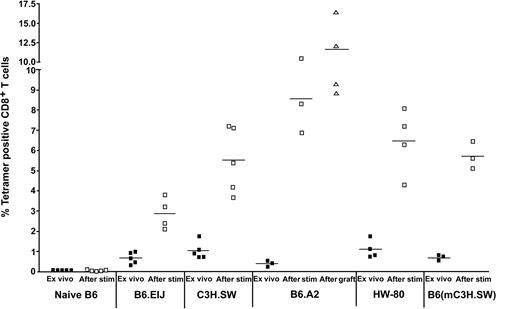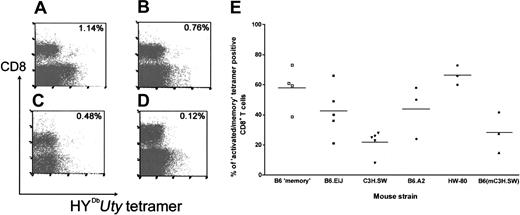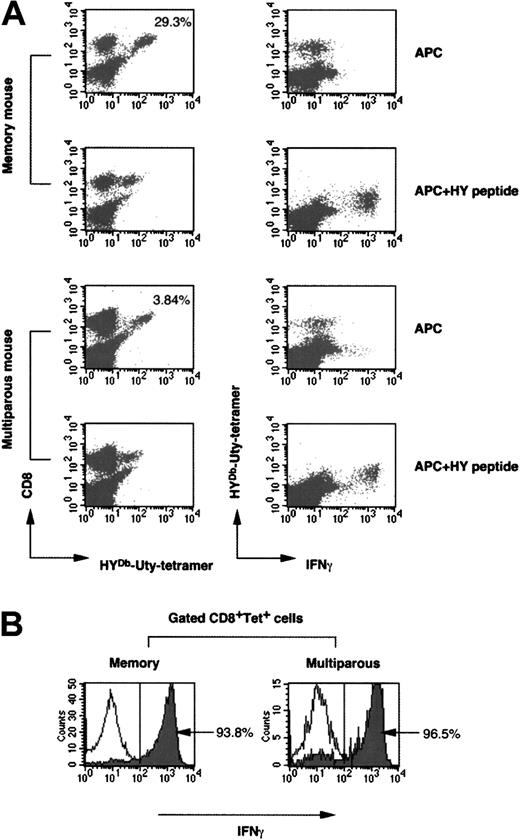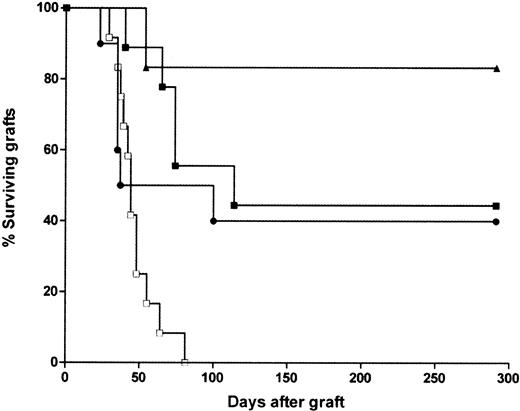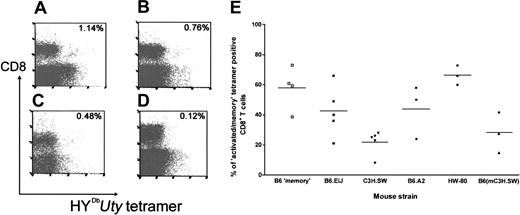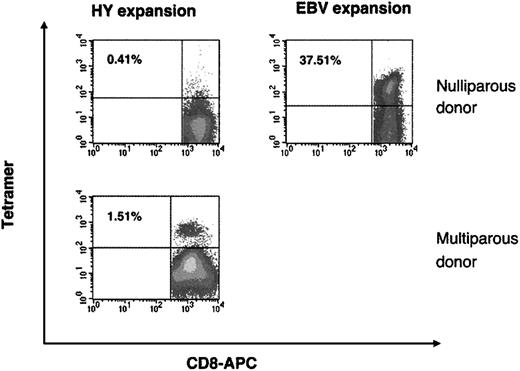Abstract
One of the factors that increases the risk of graft-versus-host disease following allogeneic stem cell transplantation is the use of multiparous females as donors. Since minor histocompatibility (H) antigens are the main targets of graft-versus-host and graft-versus-leukemia responses, we tested the hypothesis that multiparity could prime minor H antigen—specific T cells. We examined the peripheral lymphoid populations of multiparous mice and humans for evidence of priming of CD8+ T-cytotoxic lymphocytes against peptide epitopes of the male-specific minor H antigen, HY. In contrast to naive females, multiparous females have measurable levels of circulating HY-specific tetramer-positive T lymphocytes, which can be readily expanded in vitro. These findings have implications for the in vitro generation of T-cell clones as reagents for immunotherapy for tumors following stem cell transplantation. (Blood. 2003; 102:388-393)
Introduction
Allogeneic stem cell transplantation (SCT) is a potentially curative treatment for patients with various hematologic malignancies. Although the large doses of chemo/radiotherapy used in the pretransplantation regimen are certainly effective in decreasing the leukemic cell burden, the long-term therapeutic efficacy has to be ascribed to the T lymphocytes contained in donor stem cell preparation exerting a crucial antileukemic effect (graft-versus-leukemia [GVL]). Patients receiving T-cell—depleted donor stem cells have significantly higher risk of leukemic relapse compared with those receiving unmanipulated transplants.1 The proof of the crucial importance of donor T cells came from the demonstration that infusions of lymphocytes from the original stem cell donor (donor lymphocyte infusion, DLI) is the most effective treatment to restore remission in patients with leukemia who relapse after allografting.2 The GVL effect following bone marrow transplantation (BMT) or DLI is unfortunately also associated with undesirable graft-versus-host disease (GVHD) as a result of donor lymphocytes recognizing the same targets on leukemic and nonleukemic host tissues. Since donor and recipient are matched for the major histocompatibility complex (MHC), minor histocompatibility (H) antigens are considered the most important targets.3 Minor H antigens are peptides derived from polymorphic proteins presented on the cell surface by MHC molecules: they are recognized by alloreactive T cells. Currently, a small number of minor H antigens have been identified in humans at the gene and peptide level but these include some for which there is clinical evidence of immunodominance.4,5 Despite minor H antigens being the targets of both GVL and GVHD, a GVL effect can be achieved without necessarily producing GVHD.6-8
Some factors have been identified in playing a causative role in GVHD after SCT or DLI in the clinical setting.9 Sex mismatch with a female donor is among the major risk factors, as are recipients with female donors who have undergone multiple pregnancies: they have a higher rate of GVHD than recipients with male donors.10-12 This clinical association may be due to the fact that pregnancy can result in exposure of the mother to fetal antigens derived from paternal genes, including minor H antigens encoded by autosomal and/or Y chromosome minor H genes.3 Studies of multiparous mice as well as humans could be informative: the ability of inbred mice to respond to male-specific minor H antigens (HY) encoded on the Y chromosome provides a good model for testing the effect of pregnancy on the T-cell repertoire to defined minor H epitopes. Females of H2b mouse strains normally reject syngeneic male skin and generate MHC-restricted HY-specific CD4+ and CD8+ T cells.13 The HY peptide specificity of these includes the immunodominant H2Db-restricted, Uty-encoded peptide, WMHHNMDLI14 ; the subdominant Smcy-encoded peptide, KCSRNRQYL,15 also restricted by H2Db; and the H2Ab-restricted Dby-encoded peptide, NAGFNSNSSRSS.16 This information facilitates the identification and quantitation of HY-reactive T cells by tetramers and elispot and intracellular cytokine staining17 from female mice following exposure to syngeneic male cells.
Multiparous HY responder strains C57BL/6 and C57BL/10 (H2b mice) have been reported to be tolerant of syngeneic male skin grafts18 and are unable to generate in vitro cytotoxic responses following in vivo immunization.19 Tolerance can be adoptively transferred from multiparous females to naive neonatal recipients,18,20 a result suggesting transfer of a regulatory population of cells able to impose nonresponsiveness on the emerging T-cell repertoire of recipient females.21
We here present proof of principle that female mice and humans exposed to male-specific histocompatibility (HY) antigens during pregnancy with male fetuses show evidence of immunization or “priming” to HY. The paradoxical finding that multiparous mice are hyporesponsive or tolerant to syngeneic male grafts in vivo has been probed for evidence of covert responsiveness using the HYDbUty tetramer. Tetramer-positive CD8+ T cells specific for HY are not found in the peripheral circulation of naive females, nor can they be generated in mixed lymphocyte culture of spleen cells from naive females with male cells. In contrast, HY tetramer—positive cells specific for the immunodominant H2Db-restricted, Uty-encoded peptide, WMHHNMDLI, are readily demonstrable in peripheral blood lymphocytes (PBLs) and spleen of multiparous mice, and these can be expanded 10-fold during a single round of in vitro stimulation. Similar evidence for in vivo priming was found in the PBLs of an HLA-A2 woman who had given birth to 3 sons.
Materials and methods
Mouse studies
Mice. C57BL/6EiJ (B6), HW80, C3H.SW/SnJ (C3H.SW), and B6.HLA-A2 transgenic (B6.A2) mice were bred and maintained in the Biological Services Unit at Hammersmith Hospital, London. The multiparous mice were 6- to 9-months old and had given birth to 4 to 7 litters, the last litter more than one month before testing. Naive female B6 mice of the same age were used as negative controls. Age-matched B6 female mice previously immunized following rejection of a syngeneic male skin graft several months previously were used as positive controls (“memory” mice).
Skin grafting. Skin grafting was conducted as described previously,22 and after removal of the plaster casts, the grafts were observed every 2 to 3 days. Grafts were scored as being rejected when less than 10% viable tissue was visible.
Tissue-culture media. RPMI 1640 (Gibco BRL, Paisley, United Kingdom) supplemented with 10% fetal calf serum (Biogen, Cambridge, MA), HEPES (N-2-hydroxyethylpiperazine-N′-2-ethanesulfonic acid; 10 mM), penicillin (100 IU/mL), streptomycin (100 μg/mL; Gibco BRL), 2-mercaptoethanol (10-5 M), and l-glutamine (2 mM/mL; Gibco BRL) was used as complete medium.
Preparation of tetramers. MHC class I tetramers were produced using a modification of the method of Altman et al23 as described previously.17 Staining of samples was performed as described previously.17
Tetramer analysis of freshly isolated or cultured spleen cells. Single spleen cell suspensions were prepared from naive, immunized (memory), and multiparous females. Aliquots of spleen cells were analyzed ex vivo following removal of B220+ cells for the presence of HYDbUty-specific T cells by tetramer staining. The remaining spleen cells (3-5 × 106/well) were restimulated with irradiated syngeneic male spleen cells (5 × 106/well) in the presence of interleukin-2 (IL-2; 10 IU/mL) in 24-well plates. After 7 days in culture, the cells were assessed by tetramer staining, and/or analyzed for interferon gamma (IFNγ) production, as described below.
Staining of intracellular cytokines for flow cytometric analysis. As described above, 7 days after in vitro stimulation with male cells, the cultured responder cells were harvested and dead cells were removed by density centrifugation. The viable activated T cells (2 × 106/mL) were restimulated with irradiated unpulsed or (100 nM HYDbUty and HYAbDby) peptide-pulsed B6 female T-cell—depleted splenocytes (4 × 106/mL) in 24-well plates for 2 hours in the presence of a protein transport inhibitor, monensin (GolgiStop; BD PharMingen, Oxford, United Kingdom). The cultured cells were harvested and incubated with 2.4G2 antibody against Fcγ II/III receptors to block nonspecific staining. They were washed, and stained with anti—CD4—fluorescein isothiocyanate (FITC), anti—CD8—peridinin chlorophyll-a protein (PerCP), and HYDbUty tetramer—phycoerythrin (PE). After washing, cells were fixed, permeabilized with Cytofix/Cytoperm solution (BD PharMingen), and washed again with 1× Perm/Wash solution (BD PharMingen), before resuspending in 1× Perm/Wash solution containing anti-IFNγ allophycocyanin (APC) or isotype-matched control antibodies. After a final wash with 1× Perm/Wash solution, the cells were resuspended in staining buffer prior to flow cytometric analysis.
Human studies
Human peripheral blood mononuclear cells (PBMCs) from an HLA-A2*0201 multiparous donor who had borne 3 male children were separated from a 50-mL blood sample and stimulated weekly with T2 cells pulsed with 10 μM of the HY HLA-A2—restricted Smcy-derived peptide, FIDSYICQV. In addition, aliquots of PBMCs from an HLA-A2*0201 nulliparous Epstein-Barr virus (EBV)—positive donor were stimulated with T2 cells pulsed with the HY peptide, or with the EBV HLA-A2—restricted BMLF1-derived peptide, GLCTLVAML, as a control. Pulsing was carried out for one hour at 37°C, after which the APCs were irradiated, washed, and added to responder cells at a ratio of 1:1. All peptides were provided by Proimmune, Oxford, United Kingdom. This study was approved by the Hammersmith Hospital Research Ethics Committee. Informed consent was provided according to the Declaration of Helsinki.
PBMCs were cultured in RPMI 1640 with Glutamax-I and 25 mM HEPES (Gibco BRL) in the presence of human AB serum 10% (Sigma, Poole, United Kingdom), 50 IU/mL human recombinant IL-2 (Roche, Basel, Switzerland), and 10 ng/mL human recombinant IL-7 (R&D Systems, Abingdon, United Kingdom). HY- and EBV-specific CD8+ T lymphocytes were detected using the HLA-A2/FIDSYICQV or the HLA-A2/GLCTLVAML tetramers, respectively (Proimmune). Tetramer-PE and mouse antihuman CD8-APC antibodies (BD PharMingen) were incubated with 1 to 2 × 106 lymphocytes for 30 minutes on ice in the dark, washed with fluorescence-activated cell sorter (FACS) buffer, and stained with the cell-viability dye propidium iodine (PI; Sigma) prior to acquisition on the FACSCalibur (BD PharMingen).
Results
Tolerance to syngeneic male skin grafts
Tolerance to syngeneic male skin grafts in a variable proportion of multiparous females of 3 H2b mouse strains is shown in Figure 1, together with the rejection times of control naive B6 mice. Not all multiparous recipients were tolerant: more than 80% of the B6.HLA-A2 cohort were retaining their test grafts for more than 300 days when the experiment was terminated. The 2 other strains, HW80 (an H1 congenic strain on a B6 background)24 and B6, show just less than 50% of the mice grafted retaining their grafts this length of time in this set of experiments. All mice were regrafted with a second syngeneic male skin graft 100 days after the first. Those that retained their first male grafts also retained their second for more than 100 days (data not shown), but those that had rejected their first graft rejected the second at a much faster tempo (< 25 days, data not shown), indicating immunization. At 100 days after the second graft, the tolerant B6 mice were injected intraperitoneally with 5 × 106 male spleen cells. This failed to induce rejection of male grafts (data not shown).
Syngeneic male skin grafts are tolerated by some multiparous mice. Multiparous female B6.EiJ (▪, n = 9), B6.A2 (▴, n = 6), HW80 (•, n = 10), and naive B6.EiJ (□, n = 12) mice were grafted with syngeneic male tail skin. Survival of skin grafts was monitored every 2 to 3 days.
Syngeneic male skin grafts are tolerated by some multiparous mice. Multiparous female B6.EiJ (▪, n = 9), B6.A2 (▴, n = 6), HW80 (•, n = 10), and naive B6.EiJ (□, n = 12) mice were grafted with syngeneic male tail skin. Survival of skin grafts was monitored every 2 to 3 days.
Tetramer analysis of peripheral T cells ex vivo from naive and multiparous mice
The ability of some multiparous mice to reject syngeneic male skin grafts suggests that pregnancy may not lead to deletion of HY-specific T cells. This was examined by staining peripheral blood lymphocytes or spleen cells ex vivo from ungrafted multiparous females with HYDbUty tetramers. There were 3 to 5 multiparous mice of each of the H2b strains (B6, C3H.SW/SnJ, HW80, and B6.HLA-A2) and 3 multiparous B6 mice (having had F1 litters with a C3H.SW male) that had between 0.25% and 2% tetramer-positive CD8+ T cells in the spleen (Figure 2, filled squares). Whereas the lower levels were barely above the baseline in naive females (around 0.01%-0.2%; Figures 2, 3D), those in multiparous mice (over 0.5%) certainly were higher and showed in dot plots as discreet populations clearly separable from CD8+ tetramer-negative T cells (Figure 3A-C). The percentages of tetramer-positive cells in HW80 and C3H.SW mice were higher than in the other strains, all of them falling in the 0.5% to 2% range (Figure 2, filled squares).
HYDbUty tetramer analysis of peripheral T cells from naive and multiparous mice. Filled squares (▪) indicate ex vivo; open squares (□), following in vitro restimulation with syngeneic male cells. Splenocytes were from naive B6, multiparous B6.EiJ, C3H.SW/SnJ, B6.HLA-A2, HW80, and B6.EiJ females mated with C3H.SW/SnJ males. In addition, spleen cells from a group of skin-grafted B6.HLA-A2 were stimulated in vitro for 7 days and analyzed for HYDbUty-specific T cells (▵). In each case the percentage of HYDbUty CD8+ T cells was assessed using MHC class I tetramers. Bars indicate means.
HYDbUty tetramer analysis of peripheral T cells from naive and multiparous mice. Filled squares (▪) indicate ex vivo; open squares (□), following in vitro restimulation with syngeneic male cells. Splenocytes were from naive B6, multiparous B6.EiJ, C3H.SW/SnJ, B6.HLA-A2, HW80, and B6.EiJ females mated with C3H.SW/SnJ males. In addition, spleen cells from a group of skin-grafted B6.HLA-A2 were stimulated in vitro for 7 days and analyzed for HYDbUty-specific T cells (▵). In each case the percentage of HYDbUty CD8+ T cells was assessed using MHC class I tetramers. Bars indicate means.
Phenotype of tetramer-positive T cells ex vivo from multiparous and memory mice. (A-C) Multiparous females of various H2b strains: HW80 (A), C3H.SW (B), and B6/Ei (C). (D) Nulliparous B6/Ei mouse. (E) Memory phenotype of tetramer-positive cells from memory (open squares) and multiparous (filled symbols) mice. The activation state of HYDbUty-specific T cells from multiparous B6.EiJ (squares), C3H.SW/SnJ (inverted triangles), B6.HLA-A2 (diamonds), HW-80 (circles) mice, and B6.EiJ females mated with C3H.SW/SnJ males (triangles) were analyzed using antibodies against CD45RB and CD62L. Bars indicate means.
Phenotype of tetramer-positive T cells ex vivo from multiparous and memory mice. (A-C) Multiparous females of various H2b strains: HW80 (A), C3H.SW (B), and B6/Ei (C). (D) Nulliparous B6/Ei mouse. (E) Memory phenotype of tetramer-positive cells from memory (open squares) and multiparous (filled symbols) mice. The activation state of HYDbUty-specific T cells from multiparous B6.EiJ (squares), C3H.SW/SnJ (inverted triangles), B6.HLA-A2 (diamonds), HW-80 (circles) mice, and B6.EiJ females mated with C3H.SW/SnJ males (triangles) were analyzed using antibodies against CD45RB and CD62L. Bars indicate means.
In vitro expansions of tetramer-positive cells from multiparous mice
Another way to distinguish background levels of tetramer-positive CD8+ T cells of naive mice from low levels of memory cells is to expand them in vitro in the presence of syngeneic male cells, since this does not lead to expansion of HY tetramer—positive cells from naive females. The results of such an experiment, using the same mice as those shown in the filled squares in Figure 2, show that the percentage of tetramer-positive CD8+ T cells after in vitro stimulation with male cells for 7 days was increased about 10-fold, to reach levels up to 10% (Figure 2, open squares). This lies within the range found following in vitro restimulation of memory cells from females immunized with syngeneic male spleen cells or after the rejection of a male skin graft.17 In contrast, 7-day cultures of PBLs or spleen from naive mice did not generate HY tetramer—positive T cells (Figure 2), and failed to do so even after several further rounds of in vitro stimulation with male cells (data not shown).
Figure 2 also shows the results of tetramer staining of in vitro restimulated cultures of spleen from multiparous B6.HLA-A2 mice that had been grafted with syngeneic male skin (open triangles). Of the 4 mice shown, 2 had rejected their grafts, while 2 retained them at the time of testing, more than 300 days after grafting. The expansions of tetramer-positive expansions had occurred for all 4 mice, reaching 10% to 20% of CD8+ T cells in the cultures.
Phenotype of tetramer-positive T cells ex vivo from multiparous and memory mice
The phenotype of tetramer-positive cells in the ex vivo T-cell samples from ungrafted multiparous mice was tested and compared with those of memory mice that had rejected a syngeneic male graft. Unlike the tetramer-positive cells from naive H2b females, in which less than 10% show a memory phenotype (CD45RBint, CD62Llow, data not shown) 20% to 70% had this phenotype in those from both multiparous and memory females, consistent with previous exposure and response to cognate antigen (Figure 3E).
Functional assessment of tetramer-positive cells from multiparous and memory mice
The function of HY tetramer—positive cells generated in culture from spleens of multiparous, ungrafted mice was compared with that from skin-graft—rejected memory mice by assessing intracellular IFNγ staining of tetramer-positive cells. A representative result is illustrated in Figure 4. This shows percentages of tetramer-positive cells as higher in the memory than the multiparous mouse (29% in comparison with 4%, Figure 4A, first and third panels in the left column). However, cells cultured with HY peptide to elicit IFNγ production have similar down-regulation of cell-surface tetramer in both multiparous and memory mice (second and fourth panels in the left column). T-cell receptor (TCR) down-regulation, visualized by tetramer, is generally seen following addition of cognate peptide, placing time limits on the time such cells can be incubated with peptide to elicit intracellular cytokine. In our hands this is 2 hours. Most significantly, the peptide-specific IFNγ production by tetramer-positive T cells is the same for memory and multiparous mice, with more than 90% of the tetramer-positive cells making IFNγ in response to HY peptide but not in its absence (Figure 4A, right column). This is also depicted in histogram form in Figure 4B, which shows IFNγ production by gated tetramer-positive cells cultured with (filled histograms) or without (open histograms) HY peptide. At the single-cell level tetramer-positive cells from multiparous and memory mice are indistinguishable, suggesting that the tetramer-positive cells detected ex vivo in multiparous mice are potentially as functional as memory cells when exposed in vitro to male antigen.
Functional assessment of tetramer-positive cells from multiparous and memory mice. (A) Spleen cells from memory B6 mice that had rejected male skin grafts, and from multiparous B6 mice, were stimulated with irradiated syngeneic male spleen cells plus IL-2 for 7 days. The cells were analyzed for IFNγ production by intracellular staining, as described in detail in “Materials and methods.” In brief, after removing the dead cells, the viable cells were restimulated with unpulsed APCs or with HY peptide—pulsed APCs for 2 hours in the presence of monensin. After harvesting, the cells were stained with anti-CD4, anti-CD8, and HYDbUty tetramer. After fixation and permeabilization, the cells were stained with anti-IFNγ prior to flow cytometric analysis. Representative results are shown from a memory and a multiparous mouse. The percentages shown in 2 of the panels in the left column indicate tetramer-positive cells within the CD8+ T-cell populations of each mouse. (B) IFNγ production by gated CD8+ tetramer+ T cells is represented as histograms (filled, APC+HY peptide; unfilled, APCs alone). The percentage represents the frequency of IFNγ-producing cells within the gated tetramer+ CD8+ T-cell population.
Functional assessment of tetramer-positive cells from multiparous and memory mice. (A) Spleen cells from memory B6 mice that had rejected male skin grafts, and from multiparous B6 mice, were stimulated with irradiated syngeneic male spleen cells plus IL-2 for 7 days. The cells were analyzed for IFNγ production by intracellular staining, as described in detail in “Materials and methods.” In brief, after removing the dead cells, the viable cells were restimulated with unpulsed APCs or with HY peptide—pulsed APCs for 2 hours in the presence of monensin. After harvesting, the cells were stained with anti-CD4, anti-CD8, and HYDbUty tetramer. After fixation and permeabilization, the cells were stained with anti-IFNγ prior to flow cytometric analysis. Representative results are shown from a memory and a multiparous mouse. The percentages shown in 2 of the panels in the left column indicate tetramer-positive cells within the CD8+ T-cell populations of each mouse. (B) IFNγ production by gated CD8+ tetramer+ T cells is represented as histograms (filled, APC+HY peptide; unfilled, APCs alone). The percentage represents the frequency of IFNγ-producing cells within the gated tetramer+ CD8+ T-cell population.
Tetramer-positive cells in multiparous and nulliparous human donors
Although only very small numbers of A2/HY/SMCY tetramer—positive cells were found ex vivo in the PBLs of an HLA-A2 woman who had borne 3 sons, these cells were expanded following weekly restimulation in vitro with T2 cells pulsed with the relevant HY peptide, FIDSYICQV (Figure 5). In contrast, PBLs from an age-matched nulliparous woman did not generate A2/HY/SMCY tetramer—positive cells following culture under the same conditions, although HLA-A2—restricted EBV peptide—specific tetramer expansions were readily detected following culture with T2 cells pulsed with this peptide (Figure 5).
Tetramer-positive cells in multiparous and nulliparous human donors. The figure shows the proportion of HLA-A2/FIDSYICQV(HY) or HLA-A2/GLCTLVAML(EBV) tetramer+, CD8+ T cells logically gated from the live lymphocyte (PI negative) population, following weekly restimulations of PBMCs from a multiparous donor with HY-pulsed T2 cells, compared with PBMCs from a nulliparous donor restimulated with either HY- or EBV-pulsed T2 cells. Tetramer staining of the CD4 T-cell population from the same donors was a negative control (data not shown).
Tetramer-positive cells in multiparous and nulliparous human donors. The figure shows the proportion of HLA-A2/FIDSYICQV(HY) or HLA-A2/GLCTLVAML(EBV) tetramer+, CD8+ T cells logically gated from the live lymphocyte (PI negative) population, following weekly restimulations of PBMCs from a multiparous donor with HY-pulsed T2 cells, compared with PBMCs from a nulliparous donor restimulated with either HY- or EBV-pulsed T2 cells. Tetramer staining of the CD4 T-cell population from the same donors was a negative control (data not shown).
Discussion
It is clear that although a significant proportion of multiparous mice of H2b strains fail to reject syngeneic male skin grafts (Figure 1; Billingham18 and Simpson et al19 ), we provide for the first time evidence that this tolerant state is not accompanied by clonal deletion of CD8+ T cells specific for the immunodominant HY epitope WMHHNMDLI restricted by H2Db (Figures 2, 3). Rather, these tetramer-positive cells are present at levels comparable with memory cells in mice immunized with male cells weeks or months previously.17 They also express phenotypic markers of memory cells (Figure 3E), and, like them, when cultured in vitro with syngeneic male cells, expand (Figure 2, open symbols) and produce IFNγ following further exposure to HY peptides (Figure 4). Interestingly, these are also the features of tolerance induced in B6 females by pretreatment with HY peptides before placing a test male skin graft (James et al25 ; and J.-G.C. et al, manuscript submitted). Figure 5 provides evidence that multiparity in humans can also prime to minor H antigens. This is in agreement with recent data from Verdijk et al (manuscript submitted) investigating minor H-specific tetramer responses from 6 multiparous women. These results suggest that pregnancy can result in the initiation of T-cell responses to alloantigens of paternal origin expressed by the fetus. This is perhaps not surprising, especially in multiparous females, since some leakage of fetal cells into the maternal circulation during pregnancy and/or birth does occur. In human pregnancies with rhesus incompatible fetuses, sensitization in a proportion of cases leads to harmful antibodies that cross the placenta and can damage or kill the fetus.26 Transplantation antigens can also stimulate antibody responses, and HLA-typing antisera can be obtained from multiparous women.27
Since transplantation antigens also stimulate T-cell responses, the question has often been debated as to why these cells do not generally mount an attack on the fetus expressing foreign (to the mother) paternal alloantigens.28 These include minor H antigens as well as those encoded by MHC genes. There are a number of mechanisms that probably contribute to this failure to mount an immune attack against the fetus. One is the late expression of MHC antigens during fetal development.29 This does not take place until the final trimester of pregnancy, and in the absence of MHC class I and II molecules, responses to neither allogeneic MHC nor MHC-restricted minor H antigens can be mounted. Nor does the trophoblast express classic MHC molecules: however, the nonclassical MHC class I molecules HLA-E and HLA-G are expressed in human fetal trophoblast, and this is the ligand for inhibitory NK receptors, and hence may contribute to protecting the conceptus from immune attack.30 There have been recent reports that maternal decidual cells express the enzyme indoleamine 2,3 dioxygenase (IDO) that inhibits T-cell function by catabolizing tryptophan: treatment of female mice pregnant by MHC-mismatched males with a pharmacologic IDO inhibitor causes fetal death and resorption.31
Finally, there is evidence that allogeneic fetuses can be protected from immune attack by transient peripheral tolerance during pregnancy. This comes from TCR transgenic mice expressing TCRs against the alloantigen, H2Kb. During pregnancy with H2b males, peripheral T cells of TCR transgenic females reversibly down-regulate their cognate TCRs until after birth of the F1 pups.32,33 This is an example of nondeletional peripheral tolerance, which has also been reported in other situations34,35 in which T cells are confronted with a “nonself” antigen expressed only in the periphery.
From the results presented here it appears that maternal T cells specific for at least one set of paternal minor H antigens, HY, can be primed during pregnancy, so that T-cell—precursor frequency is increased and the phenotype changed to that of memory T cells. This allows detection in peripheral blood ex vivo and for expansion on further exposure in vitro to cells expressing the relevant MHC restriction molecule and the HY peptide. This is in strong contrast to the situation in naive females, from which it is not possible to expand such populations in vitro in mixed lymphocyte reaction (MLR) (Figure 2). The characteristics of HY-specific T cells from multiparous mice are closer to the qualitative and quantitative changes of minor H-specific T-cell precursors in individuals previously exposed in vivo by immunization with lymphoid cells expressing these antigens, from which in vitro expansions can readily be made, and clones isolated.17 The finding of evidence for T-cell priming in outbred humans makes it likely that this can recur by indirect presentation, a relatively inefficient route as already described in mice.17
These findings provide evidence that the increased risk of GVHD in BMT from multiparous female donors is associated with expansions of memory T cells directed against recipient minor H antigens, but they also raise the possibility that multiparous females may represent a source of preprimed precursors to minor H antigens. This could provide the starting point for generation in vitro of minor H-specific T cells of selected specificities for immunotherapy, for example, for DLIs used to treat leukemia patients that have relapsed after BMT.2 Currently this procedure, using donor PBLs ex vivo, with no selection of T cells for or against particular recipient alloantigens, carries with it the risk of GVHD. There is evidence from a mouse model system that transfusion of T cells specific for single minor H antigens, even against ubiquitously expressed ones, can be tumor-selective and not cause GVHD.36 There is also evidence from studies in humans that while some minor H genes are expressed ubiquitously, such as the HY gene SMCY, others are selectively expressed on hematopoietic cells, for example the HY gene UTY and the autosomal genes HA-1 and HA-2 (de-Bueger et al;6 Mutis et al;37 Dickinson et al;38 and S. Riddell and E. Warren, unpublished data, May 2002).
The practical problem is how to generate T cells of the relevant specificities in vitro, given the requirement for previous in vivo exposure to antigen. In pregnancy the fetus may be protected from maternal immune attack, but not apparently by deletion of potential effectors, following the finding of memory T cells in both murine and human multiparous individuals. These primed cells in humans are, however, a potential starting point for generation of immunotherapeutic effectors against selected minor H specificities.
Prepublished online as Blood First Edition Paper, March 20, 2003; DOI 10.1182/blood-2002-10-3170.
Supported by the Leukaemia Research Fund and the Medical Research Council.
The publication costs of this article were defrayed in part by page charge payment. Therefore, and solely to indicate this fact, this article is hereby marked “advertisement” in accordance with 18 U.S.C. section 1734.
The authors would like to thank Drs Diane Scott and Julian Dyson for reading the manuscript critically; Mrs Vivien Tikerpäe for assistance with its preparation; and Dr Diane Scott for assistance with the figures.


